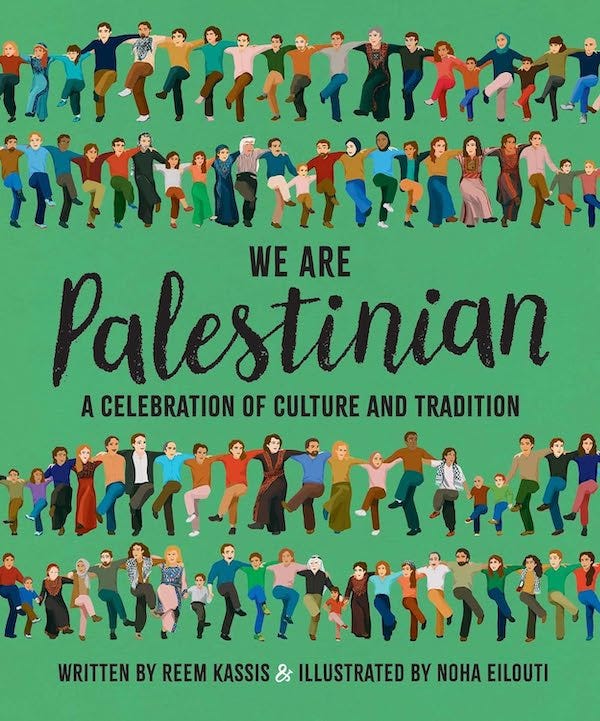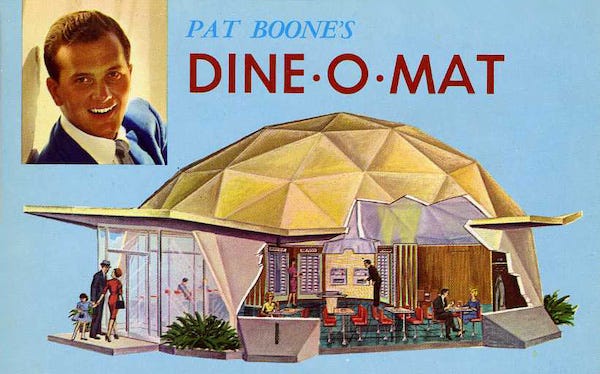Wednesday Walk: Food Diplomacy
The limits of sharing a meal, microwave dinners on the go, and seeing Gaza everywhere
Welcome to Willoughby Hills!
Every Wednesday (or in this case, Friday), I offer a few short ideas that I hope will inspire you to do some more reading, thinking, and exploring. Let’s take a little walk together and see where the path leads…
Another Long Week
Good Friday morning! Like with last week, I’ve been late to my usual publishing schedule of Sundays and Wednesdays. I’ve been working on preparing two households: my new one for us moving in and my old one for sale. It’s been a week of painting, doing small repairs, packing, and shuttling boxes back and forth.
I did edit and release a new episode of the podcast that I produce for
. In this one, interviews Asma Abu-Dahab, a Jordanian-American whose grandfather was a Palestinian Nakba survivor. If you have time, I highly recommend listening to the new episode. You can find it here, or by subscribing to Abolition, Liberation, Solidarity in your favorite podcast app.And if you haven’t heard it yet, please check out my interview for Willoughby Hills with Sarah Mock about how American agriculture and land use informs our social fabric as a country.
I’m hoping to have some time to come up for air soon, but this unpredictable schedule may need to continue a bit longer. I’m curious to hear your thoughts too- are there days that you find you’re able to engage more with my content than in the past or do you miss the routine of my old posts? Please share your thoughts in the comments!
The Limits of Humanization
I’ve written about author Reem Kassis in this newsletter before. She’s a Palestinian from Jerusalem who has written some amazing books about Palestinian culture.
I had previously recommended her book We Are Palestinian: A Celebration of Culture and Tradition, which was illustrated by Noha Eilouti. It’s designed for older children to discuss the food, culture, and important figures in Palestinian history.
But Kassis is probably best known as a food writer and author of the book The Palestinian Table.
She wrote a piece for The Atlantic last week that’s worth a read titled “They Ate at My Table, Then Ignored My People.” It’s about how Kassis had always been encouraged by people’s embrace of her Palestinian recipes, thinking that “food diplomacy” would help humanize her people for outsiders. She writes:
“My dining gatherings grew in both number and personal meaning; for me, they were a vital source of joy and community. Although I might not even have been conscious of it at the time, they were also a way to humanize Palestinians, a people so often discussed in the U.S. as either victims or perpetrators of conflict. Inviting friends from various cultures into my home was in some way an ‘audition’—as the Palestinian American writer Hala Alyan has described it—a chance for some of them to see my people’s humanity.”
After October 7 though, she’s learned the limits of this culinary exchange of cultures:
“The shift was also striking on a personal level. Although many people I know marched and protested against the killing and starvation of civilians in Gaza, others who had once relished my hospitality and cooking, and had been vocal advocates for the rights of women, immigrants, or Ukrainians—whether on social media, in street protests, or at the ballot box—were now conspicuously silent.”
Ironically for my family, food diplomacy has had the exact opposite effect. Since October 7, we have found that food has been one of the most present ways for us to engage with Palestinian culture. I’ve discussed in this newsletter how we’ve purchased olive oil from small farmers in the West Bank, and Palestinian recipe books including those by Kassis, have taught us new recipes and brought new flavors into our house.
I like to still believe that art in all forms, whether music, film, poetry, or food, can impact the way that people feel and think. But perhaps I am still naive on this point too.
Kassis’s entire piece is available to read on her website without the paywall.
Gaza is Everywhere
I have also been thinking for several weeks about how the U.S. and Israeli approach to Gaza isn’t exactly novel. I was shocked when reading Daniel Immerwahr’s book How to Hide an Empire: A History of the Greater United States, that my grandfather’s home country of the Philippines had experienced a similar bombardment during World War II.
The Philippines had been essentially a U.S. colony since 1898, but Manila was occupied by the Japanese military for much of World War II. Towards the end of the war, American troops came to reclaim the city. Most Japanese forces evacuated, but a few stayed behind.
The U.S. proceeded to indiscriminately bomb large portions of Manila under the pretense of rooting out Japanese soldiers who they claimed were hiding amongst civilians (sound familiar?). In the end, the city was largely destroyed, 17,000 Japanese troops were dead, and more than 100,000 Filipino civilians (who at the time were Americans) were also killed.
This was a history I only learned of recently, but when I did, I couldn’t help but see echoes of Gaza.
As I’ve written about before, my own connection to my Filipino roots is tenuous and has been something I’ve been exploring more.
I wanted to share an amazing conversation that taught me a lot with Filipino-American Jeff Mabute-Louie and comedian/actor/activist Amanda Seales. It’s a long talk, but it goes into a lot of Filipino history and also looks at American empire and how legislation like a TikTok ban ties in to Gaza and Israel.
Jeff and his wife Bianca just launched a new podcast called Good Thunder. Give that a listen too!
“Dinner” with Pat Boone
Finally, ending this week on a lighter note, I’ve been reading an interesting book about roadside America from 1986 called Orange Roofs, Golden Arches by Philip Langdon. (Ironically, Philip also co-authored a book for This Old House, although I’ve never met him).
In Orange Roofs, Golden Arches, Philip traces the history of our modern (at least through 1986) roadside fast food restaurants.
It may be hard to believe now, but at one time, efficiency was praised above all else when it came to fast food. People wanted food delivered in seconds, even if it meant compromising on quality or customization.
At one point, Langdon discusses some ideas that took the idea of efficiency too far. I’ve discussed Automats in this newsletter before, which were basically cafeterias in city locations in the early 20th century where prepared food was placed in self-serve vending machine slots. Hot food was delivered hot and cold food was delivered cold.
By the 1950s, several folks tried to take the concept of the automat to the highway, but with one major difference. Instead of having a kitchen on site and delivering food at the proper temperature, these roadside automats were made of vending machines with frozen dinners and a self-serve microwave where customers could heat their purchased food.
If this sounds unappetizing- yes, it is. The concept didn’t last more than a few years.
Langdon rattled off a few of the brands that tried this in his book, and one really caught my eye for some reason: Pat Boone’s Dine-O-Mat.
Apparently singer Pat Boone licensed his name and likeness to a version of these roadside automats, although I could only find one article about them.
It’s unclear how many of these restaurants even opened, although I was able to find a source on Reddit who called out that there is still at least one of these buildings still in existence in Little Ferry, NJ, just across the river from Manhattan on U.S. Route 46 near the junction of Interstates 95 and 80.
The building has housed an Avis car rental office for several years.
Apparently the ramped sides of the building are also popular with skateboarders.
It’s fascinating to me that this little rental car office was once the seed for a potential nationwide microwave dinner chain restaurant themed to a 1950s singer. The seed just didn’t quite germinate and we’re left with this strange roadside relic.
I publish new issues every Wednesday and Sunday. Sign up to always receive the latest issue and support my work:
Other Wednesday Walks
If you’ve missed past issues of this newsletter, they are available to read here.







